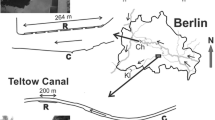Abstract
In Britain, lightly trafficked canals frequently contain diverse, productive macrophyte communities. These represent important habitats for macroinvertebrates and fish while having a high intrinsic value in nature conservation terms. As recreational boat traffic increases, fragile macrophytes are progressively eliminated and the biomass of the remaining species is greatly reduced, thereby adversely affecting weed-associated animals and ultimately simplifying the structure of the whole ecosystem. From the viewpoint of aesthetics, nature conservation and fisheries management,ecological enhancement of these traffic impacted ecosystems is desirable but options are limited by channel size and the intensity and type of disturbance. Backwater areas connected to the main channel but apparently remote from traffic influences ought however, to provide a minimally-disturbed refuge for macrophytes and dependent organisms. An extensive field survey was undertaken to test this hypothesis and evaluate the potential for exploiting backwater sites as ‘off-line’ nature reserves. Principal determinants of vegetation structure and species diversity are identified and discussed and are used to prescribe a set of ideal characteristics for prospective backwater nature reserves and to forecast likely management problems.
Similar content being viewed by others
References
Al Mufti, M. M., C. L. Sydes, S. B. Furness, J. P. Grime & S. R. Band, 1977. A quantitative analysis of shoot phenology and dominance in herbaceous vegetation. J. Ecol. 65: 759–791.
Bhowmik, N. G. & J. R. Adams, 1989. Successional changes in habitat caused by sedimentation in navigation pools. Hydrobiol. 176/177: 17–27.
Brierley, S. J., D. M. Harper & P. J. Barham, 1989. Factors affecting the distribution of aquatic plants in a navigable lowland river; the River Nene, England. Reg. Rivers: Res. & Mgmt 4: 263–274.
Department of the Environment & Welsh Office (1986) River Quality in England & Wales, 1985. London, HMSO.
Hanbury, R. G., 1986. Conservation on canals: a review of the present status and management of British navigable canals with particular reference to aquatic plants. Proc. EWRS/AAB 7th Symposium on Aquatic Weeds. Loughborough.
Haslam, S. 0M., 1978. River Plants. Cambridge University Press. 396 pp.
Hejny, S. & S. Husak, 1978. Higher plant communities. In D. Dykyjova & J. Kvet (eds), Pond Littoral Ecosystems: Structure & Functioning, Berlin: Springer-Verlag: 23–62.
Holmes, N. T. & C. Newbold, 1984. River Plant Communities-Reflectors of water and substrate chemistry. Nature Conservancy Council, Peterborough, England.
Lambert, J. M., 1947. Biological flora of the British Isles. Glyceria maxima (Hartm.) Holmb. J. Ecol. 34: 310–344.
Lousley, J. E., 1976. Flora of Surrey. David & Charles.
Murphy, K. J., R. G. Hanbury & J. W. Eaton, 1981. The ecological effects of 2-methylthio triazine herbicides used for aquatic weed control in navigable canals. I. Effects on aquatic flora and water chemistry. Arch. Hydrobiol. 91: 294–331.
Murphy, K. J. & J. W. Eaton, 1983. Effects of pleasure boat traffic on macrophyte growth in canals. J. Appl. Ecol. 20: 713–729.
Murphy, K. J., N. J. Willby & J. W. Eaton, 1995. Ecological impacts and management of boat traffic on navigable inland waterways. In D. M. Harper & A. J. D. Ferguson (eds), The Ecological Basis for River Management, John Wiley: 427–442.
Nature Conservancy Council, 1989. Guidelines for selection of Biological SSSIs. NCC. Peterborough, England. 288 pp.
Peck, J. H. & M. M. Smart, 1986. An assessment of the aquatic and wetland vegetation of the Upper Mississippi River. Hydrobiol. 136: 57–76.
Stewart, A., D. A. Pearman & C. D. Preston, 1994. Scarce Plants in Britain. JNCC, Peterborough, England, 515 pp.
Weisner, S. E. B., 1991. Within-lake patterns in depth penetration of emergent vegetation. Freshwat. Biol. 26: 133–142.
Wheeler, B. D. & S. C. Shaw, 1991. Above-ground crop mass and species richness of the principal types of herbaceous rich-fen vegetation of lowland England & Wales. J. Ecol. 79: 285–302.
Willby, N. J. & J. W. Eaton, 1993. The Distribution, Ecology and Conservation of Luronium natans (L.) Raf. in Britain. J.Aquat. Plant Mgmt 31: 70–76.
Wright, R. M. & V. E. Phillips, 1992. Changes in the aquatic vegetation of two gravel pit lakes after reducing the fish population density. Aquat. Bot. 43: 43–49.
Author information
Authors and Affiliations
Rights and permissions
About this article
Cite this article
Willby, N.J., Eaton, J.W. Backwater habitats and their role in nature conservation on navigable waterways. Hydrobiologia 340, 333–338 (1996). https://doi.org/10.1007/BF00012777
Issue Date:
DOI: https://doi.org/10.1007/BF00012777




